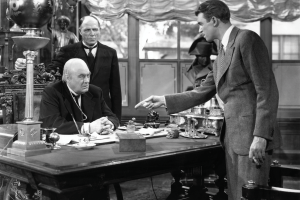Recent films and TV series shine a light on the plight of aliens among us.
Television and movie screens were chock-full of aliens this summer: scary extraterrestrials cast as villainous invaders bent on humanity’s annihilation or hapless intergalactic travelers victimized by our own inhumanity to strangers.
In TNT’s Falling Skies, Columbia Pictures’ Battle: Los Angeles, and Universal Pictures’ genre-busting Cowboys and Aliens, an armada of merciless monsters from outer space launched a blitzkrieg invasion of Earth, slaughtering and enslaving local inhabitants like cattle. Meanwhile, in J. J. Abrams’ Super 8, the still-beastly brute from outer space turns out to be an innocent traveler captured, betrayed, and tortured by greedy humans.
This ambivalence about strangers from outer space is not new. For more than a century, sci-fi tales about aliens have been of two minds as to whether the strange creatures crawling out of their smoldering spaceship were good or evil. Stories about extraterrestrials have long explored the psychology of our conflicted relationship to the stranger, either tapping into a xenophobic terror of dangerous outsiders or sympathetically uncovering the shared humanity tying us to our unrecognized neighbors.
Beginning in 1898 with H. G. Wells’ War of the Worlds, most sci-fi sagas about aliens have portrayed extraterrestrial visitors as merciless fiends, and in tale after tale legions of intergalactic imperialists launched countless waves of invasions on Earth’s shores, seeking to annihilate and enslave our civilization. Resistance, these inhuman monsters repeatedly announced, was futile.
The irony of this xenophobic response to strangers from outer space comes from the fact that Wells wrote War of the Worlds at the height of British imperialism, when English forces and technology had conquered or colonized a quarter of the human race, and from the fact that the heyday of sci-fi in Hollywood came at the peak of the Cold War, when American neo-imperialism had corralled half the planet into its orbit.
In many ways these sci-fi stories demonizing alien invasions mirrored our own colonial guilt about the conquest and destruction of other societies. Perhaps we were the monsters we were railing about in these sci-fi stories.
At the same time, a smaller group of sci-fi dramas have explored what might be called, for the lack of a better term, the “humanity” of these strangers from outer space. Before Steven Spielberg gave us E.T. and Close Encounters of the Third Kind, films like The Day the Earth Stood Still suggested that aliens from outer space might be much more civilized than we puny earthlings, an idea that resurfaced in Cocoon, Starman, and the more recent District 9 and Avatar. In these more reflective sci-fi stories, earthlings were often the universe’s beasts and monsters, particularly when we treated strangers like outcasts and fiends.
Given the profound ambivalence sci-fi stories have had about aliens, it is particularly ironic that the summer’s biggest alien film was a Western, since the Western also explored our nation’s relationship to the strangers it conquered and colonized. Early cowboy movies tapped into the fear white settlers had of the so-called “savages” these “civilized” farmers and townsfolk had invaded and annihilated, with Indians appearing as marauding and merciless villains. Later Westerns (in the ’50s and ’60s) began to explore the injustice and inhumanity of the way the West was won, and told a more accurate and disturbing tale of the West’s true “aliens.”
Still, the best alien movie this summer came without spaceships, monsters, or explosive special effects. Instead, Chris Weitz’s A Better Life deals with the 30-year flood of Mexican immigrants that has brought millions of “illegal” strangers across our national borders and generated decades of political hysteria and xenophobia. It tells the story of one family whose humanity radiates through every scene of this film.
Carlos Galindo is a hardworking undocumented Mexican gardener trying to make a decent living and provide for his son while avoiding the snares of INS agents and gangbangers alike. Like millions of other undocumented workers, he toils from dawn to dusk tending the gardens and lawns of people who treat him as a foreigner. He hopes to secure a future for his son Luis so the boy will be able to move out of their dangerous East Los Angeles neighborhood and secure a piece of the American dream.
Like the rest of us, Carlos and Luis are imperfect, flawed creatures, often beset by forces larger than themselves. But their flaws and mistakes do not set them apart as aliens and outcasts. Instead, they reveal a humanity they share with those of us watching their story. Weitz has taken one of the millions of “aliens” walking our streets (and tending our lawns, picking our strawberries, and caring for our children) and shown us the humanity that ties us to them, that makes them, as Adam said of Eve, bone of our bone and flesh of our flesh.
Both types of “alien” movies explore the fear we experience when encountering the stranger. On the surface xenophobic tales of monstrous invaders from outer space give voice to our terror of the dangerous outsider. Life is sometimes quite scary, and in these sci-fi stories we get to scream at creatures that threaten and frighten us. On a deeper level, however, films about both fiendish and humane “aliens” raise a more profound specter—that we might be monsters.
Directly or indirectly, each type of “alien” story reminds us that we, too, are strangers, that we ourselves have been threatening and monstrous invaders, and encounters with us can be quite frightening and terrifying. And in differing ways each type of “alien” film reminds us that our terror and judgment of the stranger is what makes us monstrous and alien, and recognizing and welcoming the humanity of the stranger is what makes us truly humane.
This article appeared in the November 2011 issue of U.S. Catholic (Vol. 76, No. 11, pages 40-41).











Add comment